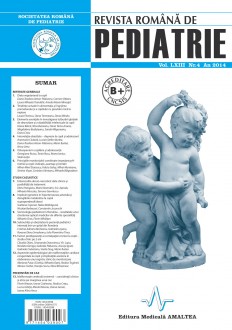SELECT ISSUE

Indexed

| |

|
|
|
| |
|
|
|

|
|
|
|
|
|
|
HIGHLIGHTS
National Awards “Science and Research”
NEW! RJP has announced the annually National Award for "Science and Research" for the best scientific articles published throughout the year in the official journal.
Read the Recommendations for the Conduct, Reporting, Editing, and Publication of Scholarly work in Medical Journals.
The published medical research literature is a global public good. Medical journal editors have a social responsibility to promote global health by publishing, whenever possible, research that furthers health worldwide.
EPIDEMIOLOGICAL ASPECTS OF CONGENITAL HEART MALFORMATIONS IN CHILDREN AND THEIR IMPLICATIONS IN DEVELOPING A CLINICAL MONITORING REGISTRY
Mariana Puiac (Ciorba), Mihaela Opriş, Rodica Toganel, Marius Ciorba, Horatiu Suciu and Klara Brinzaniuc
ABSTRACT
Introduction. With an estimated incidence of 6 cases to 1000 births worldwide, congenital cardiac malformations (CHM) are one of the main causes of death during the fi rst year of life. The main issues regarding CHM management in Romania are the lack of data that describe the true incidence on population level, lack of standardized diagnosis and CHM reporting at national level. In Romania we see only local attempts at establishing such a CHM registry.
Objectives. Measuring and analysing the incidence of CHM in children within the Pediatric Cardiovascular center of the Emergency Cardiovascular and Transplant Institute in Targu Mures (IUBCvT) in order to determine de rate of enrollment, conturing the registration and follow-up form for CHM.
Material and methods. We have conducted a retrospective, descriptive study concerning children discharged between 2008-2013, with a main diagnosis or comorbidity belonging to the category Q20-Q28 (Congenital cardiac malformations – ICD 10 AM), belonging to the Pediatric Cardiovascular center of IUBCvT. The study group was made up of 839 new-borns discharged from the Neonatology clinic of the Mures County Emergency Clinical Hospital (SCJU) and 2181 children discharged from IUBCvT.
Results. The incidence of CHM in new-borns discharged from SCJU varied between 5.23% and 11.47%. Of the total 839 new-borns, 139 underwent surgery in the IUBCvT within the fi rst 30 days of life. The most frequent malformations found were interatrial communication (46.52%), persistent ductus arteriosus (22.10%), interventricular communication (9.04%). Disease group based morbidity within the IUBCvT demonstrates the large share of interventricular communication (20.05%), interatrial communication (15.98%) respectively of persistent ductus arteriosus (13.05%). Of the 1255 children that underwent surgery, the most frequent procedures (17.93%) were conducted for interatrial communication.
Conclusions. Establishing a CHM clinical registry is important for the screening, diagnosing, monitoring of congenital cardiac malformations as well as aiding in choosing the right treatment path.
Keywords: congenital cardiac malformations monitoring, clinical registry, cardiology
